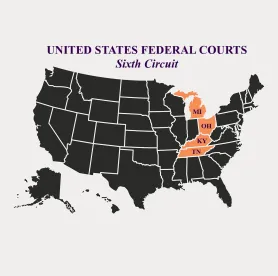Continuing an active year for Title IX precedent, the Sixth Circuit issued an en banc decision in Foster v. University of Michigan, which adds further contour to the Circuit’s Title IX “deliberate indifference” jurisprudence. It also implicitly raises—but does not necessarily answer—important questions regarding the appropriate standard of review for such claims.
In Foster, a divided panel (Judges Clay, Moore, and Sutton, with the latter dissenting) had reversed the district court’s grant of summary judgment for the University of Michigan, holding that the plaintiff had established a genuine dispute of material fact regarding whether the school was deliberately indifferent to the sexual harassment she suffered from a fellow student (the respondent). The original panel majority and dissenting opinions agreed that the plaintiff was subjected to sexual harassment and that the school had notice of that harassment. So, as is often the case, the only remaining question was whether the school’s response was “clearly unreasonable in light of the known circumstances” such that it amounted to “deliberate indifference” under Davis v. Monroe County Board of Education, 526 U.S. 629, 650 (1999). The panel originally concluded that questions of fact remained regarding whether Michigan’s response to the respondent’s harassment was actionable under Title IX, including, among others, whether Michigan had conceded that its response was inadequate yet failed to take any additional measures and whether the university adhered too long to its “no contact order” remedy in the face of mounting evidence that the respondent was likely to violate that order. 952 F.3d 765, 784–88 (6th Cir. 2020). Judge Sutton dissented, and would have held that Michigan’s response was appropriate “proportionate escalation.” The dissenting opinion at the panel stage worried that the majority was “dilut[ing] deliberate indifference into mere reasonableness.” Id. at 791–95.
The Sixth Circuit took the case en banc and affirmed the district court’s judgment, holding, as a matter of law, that Michigan did not show deliberate indifference. The en banc majority (Sutton, J.), echoing the Supreme Court in Davis, explained that the deliberate-indifference standard presents a “high bar” to imposing Title IX liability on a university and that, “[i]n an appropriate case, there is no reason why courts, on a motion to dismiss, for summary judgment, or for a directed verdict, could not identify a response as not [deliberately indifferent] as a matter of law.” (Slip Op. at 7, 14–15.) Plaintiff’s case, according the en banc majority, was such a case.
The court reviewed Michigan’s “escalating” responses to the respondent’s harassment and concluded that the school’s approach was not deliberately indifferent. (Id. at 8.) Once initially notified of the respondent’s harassment of plaintiff, the school “started with precautionary measures, moved to a verbal warning, and imposed a series of increasingly severe sanctions that led to [the respondent’s] suspension from the last class and commencement as well as a one-way flight back to California.” (Id. at 9.) The en banc court also noted Michigan’s “proactive measures” to protect plaintiff, including placement of a police detail at plaintiff’s hotel during commencement weekend in Ann Arbor and having plainclothes officers guard plaintiff during commencement itself. (Id.) The en banc court observed that plaintiff’s case was not one where the school did nothing in the face of harassment or where it continued pressing ineffectual remedies in the face of continued harassment. “It’s not a university’s job to do the impossible”—to “purg[e] [its] school[] of actionable peer harassment,” the majority noted; rather, “it’s a university’s job to respond in good faith when allegations of harassment arise.” (Id. at 7.) Finally, the en banc majority was concerned about putting schools in a heads-the-victim-wins-tails-the-harasser-sues situation whereby the remedy required to avoid Title IX liability—say, summary expulsion—automatically creates liability for the school for violating the harasser’s statutory and constitutional rights. (Id. at 12–13.) Maintaining a high bar for deliberate indifference claims, according to the majority opinion, allows Title IX recipients to maintain flexibility in their approaches to peer-based sexual harassment and helps them “hold the thin line between immediately protecting Foster and denying the harasser process before expelling him.” (Id. at 12.) The en banc court thus held, as a matter of law, that Michigan’s response to the respondent’s harassment was not deliberately indifferent, and affirmed the district court’s judgment against plaintiff.
But how to tell whether a school is acting in “good faith” and whether its actions are “clearly unreasonable”? And, more fundamentally, who should answer these questions? Judge Moore’s dissenting opinion raised these questions and answered them by pointing back to the factual nature of the dispute, which should have, in her view, resulted in the jury resolving the fact issues regarding Michigan’s alleged deliberate indifference. The dissent critiqued the majority for “stepp[ing] out of its boots and into the jury’s shoes” (id. at 28) by resolving factual disputes and for substituting a “good faith” standard of deliberate indifference for Davis’s “clearly unreasonable in light of the known circumstances” test (id. at 30 & n.7). Yet, despite these points of contention, the majority and dissenting opinions largely agreed on the substantive legal standards and on the majority of the facts, too.
Perhaps, then, the disagreement between the en banc majority and dissent in Foster is best understood as turning not on the facts or substantive law regarding deliberate-indifference claims, but instead on disagreements about the factual-versus-legal nature of the underlying question. That is, does the deliberate-indifference inquiry involve more factual or legal work, and, relatedly, who should answer the question? The majority did not articulate the precise nature of its standard of review (and was critiqued by the dissent for failing to do so), and instead grounded its resolution of the case in Davis’s oft-quoted reminder that, “[i]n an appropriate case,” a court can resolve the deliberate-indifference inquiry as a matter of law. But what did the Supreme Court mean by this? Was it simply reminding the lower courts that, where the material facts are undisputed, they may resolve these Title IX claims on their own? If so, that proposition is hardly controversial. Or does Davis suggest that the Supreme Court views the deliberate-indifference question as a legal one (or at least as a more-legal-than-factual mixed question) for courts to decide?
Foster doesn’t answer this question (likely because the majority felt it didn’t need to), but it’s worth noting that the court was concerned with “dilut[ing] deliberate indifference into mere reasonableness,” because Title IX cases “often generate triable issues of fact,” suggesting that the Sixth Circuit views the Davis standard as serving a gatekeeping function. But, though this reiterates that deliberate indifference presents a “high bar” for recovery, it doesn’t define the circumstances under which a court–as opposed to a jury–should determine if a plaintiff’s evidence clears it. At a minimum, Foster provides an additional point in the Sixth Circuit’s growing constellation of Title IX deliberate-indifference jurisprudence, and, maybe most importantly, clarifies that a plaintiff cannot survive summary judgment simply by showing harassment continued after a Title IX recipient’s initial response or by pointing to evidence that the school’s response was ineffective. (Id. at 10–11.) What, exactly, amounts to deliberate indifference will likely continue to be a fact- and context-specific inquiry, though one that may be resolved summarily by a court, at least in an “appropriate case.”




 />i
/>i
